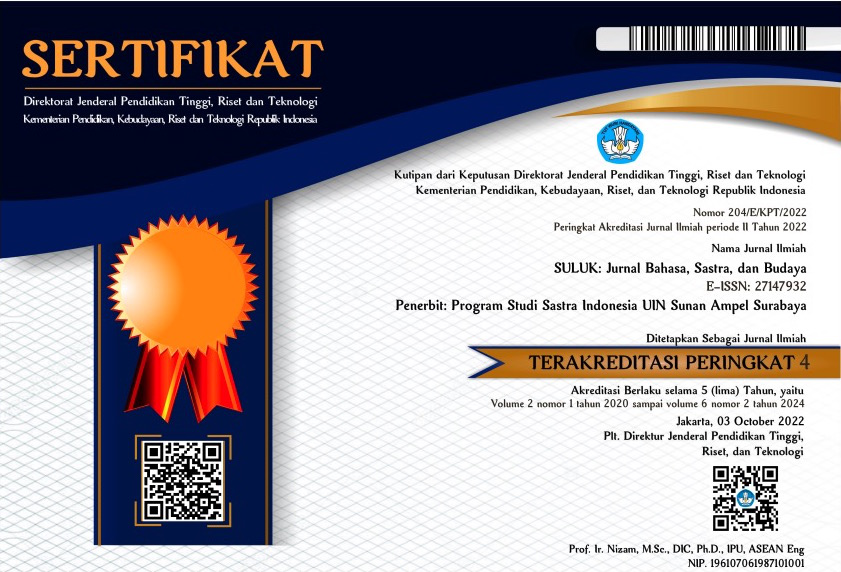Lanskap Arkeologi Situs Gosari-Gresik dalam Perspektif Prosesual dan Pasca-Prosesual
DOI:
https://doi.org/10.15642/suluk.2021.3.1.23-33Keywords:
Gosari, lanskap, prosesual, pasca-prosesualAbstract
Dalam tulisan ini Situs Gosari-Gresik dikategorikan sebagai salah satu artefak arkeologis Nusantara yang memberikan informasi terkait masa silam. Situs tersebut dipahami sebagai representasi dari perspektif Prosesual dan Pasca-Prosesual. Ruang lingkup tulisan ini menyajikan lanskap Situs Gosari sebagai representasi dari paradigma prosesual dan pasca-prosesual. Kontradiksi kedua paradigma di atas disinergikan untuk mengetahui lanskap Situs Gosari yang terdiri dari bekas tungku pembakaran gerabah, sendang, dan prasasti. Dalam hal itu paradigma pertama menjelaskan tarikh atau usia situs, jenis atau model gerabah yang dihasilkan; korelasi antarunsur arkeologi; dan peranan atau industri gerabah pada masa Majapahit. Sedangkan paradigma kedua digunakan untuk melengkapi analisis yang tidak dapat dijangkau paradigma sebelumnya, terutama terkait interpretasi terhadap sendang dalam pandangan masyarakat setempat berdasarkan tradisi lisan/folklor yang diyakini. Dari kedua paradigma tersebut dihasilkan kesimpulan bahwa kedudukan sendang memiliki peranan penting, baik dalam industri gerabah maupun kehidupan masyarakat sekitar. Selain itu, diketahui bahwa tinggalan budaya tak bendawi masa klasik tersebut masih dipelihara.
Downloads
References
Anschuetz, K., Wilshusen, R., & Scheick, C. (2001). An Archaeology of Landscapes: Perspectives and Directions. Journal of Archaeological Research, 9(2). https://doi.org/10.1023/A:1016621326415
Ashmore, W., & Knapp, B. (1999). Archaeologies of Landscape: Contemporary Perspectives. United Kingdom: Blackwell Publishers Ltd.
Earle, T. K., Preucel, R. W., Brumfiel, E. M., Carr, C., Limp, W. F., Chippindale, C., … Zeitlin, R. N. (1987). Processual Archaeology and the Radical Critique [and Comments and Reply]. Current Anthropology, 28(4). https://doi.org/10.1086/203551
Gosden, C., & Head, L. (1994). Landscape - a Usefully Ambiguous Concept. Archaeology in Oceania. https://doi.org/10.1002/arco.1994.29.3.113
Greene, K. (2003). Archaeology An Introduction. United Kingdom: Routledge.
Hodder, I. (1991a). Interpretive Archaeology and Its Role. American Antiquity, 56(1). https://doi.org/10.2307/280968
Hodder, I. (1991b). Post-modernism, Post-structuralism, and Post-processual Archaeology. In The Meanings of Things: Material Culture and Symbolic Expression (pp. 64–78). New York: Harper Collins Academic.
Hodder, I. (2005). Postprocessual and Interpretive Archaeology. In C. Renfrew & P. Bahn (Eds.), Archaeology The Key Concepts (pp. 155–159). New York: Routledge.
Hodder, I., & Hutson, S. (2003). Reading The Past: Current Approaches to Interpretation in Archaeology (Edition 3). United Kingdom: Cambridge University Press.
Hudson, C. M. (2008). Walter Taylor and the history of American archaeology. Journal of Anthropological Archaeology, 27(2). https://doi.org/10.1016/j.jaa.2008.02.001
Johnson, M. (2007). Ideas of Landscape. United State: Blackwell Publishing Ltd.
Kemendikbud, C. B. (2017). Situs Gosari. Retrieved from Sistem Registrasi Nasional Cagar Budaya website: http://cagarbudaya.kemdikbud.go.id/cagarbudaya/detail/PO2017082100014/situs-gosari
Layton, R., & Ucko, P. (1999). The Archaeology and Anthropology of Landscape: Shaping Your Landscape. Routledge.
Mundardjito, M. (2007). Paradigma dalam Arkeologi Maritim. Wacana, Journal of the Humanities of Indonesia, 9(1). https://doi.org/10.17510/wjhi.v9i1.229
Peneliti, T. (2005). Laporan Penelitian Arkeologi Teknologi Industri Tembikar Halus di Wilayah Ujung Pangkah Gresik Jawa Timur (Tahap I). Jakarta.
Peneliti, T. (2006). Laporan Penelitian Arkeologi Teknologi Industri Tembikar Halus di Wilayah Ujung Pangkah Gresik Jawa Timur (Tahap II). Jakarta.
Peneliti, T. (2009). Laporan Penelitian Arkeologi Teknologi Industri Tembikar Halus di Wilayah Ujung Pangkah Gresik Jawa Timur (Tahap III). Jakarta.
Sabloff, J. (2005). Processual Archeology. In C. Renfrew & P. Bahn (Eds.), Archaeology The Key Concepts (pp. 159–164). New York: Routledge.
Sunliensyar, H. H. (2018). Lanskap Arkeologi Dalam Perspektif Prosesual Dan Pasca-Prosesual: Studi Kasus Kompleks Megalitik Di Dataran Tinggi Jambi. Berkala Arkeologi, 38(2). https://doi.org/10.30883/jba.v38i2.267
Tanudirjo, D. A. (2019). Arkeologi Pasca-Prosesual Alam Pikir Pasca-Modernisme Dalam Arkeologi. In Makalah Bahan Ajar. Yogyakarta: Universitas Gadjah Mada.
Tilley, C. (2005). Phenomenological Archaeology. In C. Renfrew & P. Bahn (Eds.), Archaeology The Key Concepts (pp. 151–165). New York: Routledge.
Utomo, D. W. (2012). Gresik: Sebuah Catatan Perjalanan Sejarah. Retrieved November 30, 2019, from Ikatan Ahli Arkeologi Indonesia website: https://iaaipusat.wordpress.com/2012/03/19/gresik-sebuah-catatan-perjalanan-sejarah-islam/
Webster, G. (2008). Culture History?: A Culture-Historical Approach. In Handbook of Archaeological Theories.
Winarto, Y. T. (2014). Pendekatan Prosesual: Menjawab Tantangan dalam Mengkaji Dinamika Budaya. Antropologi Indonesia, 0(60). https://doi.org/10.7454/ai.v0i60.3354
Wylie, A. (2002). Thinking From Things: Essays in The Philosophy of Archaeology. London: University of California Press.
Wawancara Hasan Sadiq (Sekretaris Kecamatan Sidayu, Tokoh Masyarakat Gosari) tanggal 27 Desember 2019
Downloads
Additional Files
Published
How to Cite
Issue
Section
License
Copyright (c) 2021 Laksmi Eko Safitri

This work is licensed under a Creative Commons Attribution-ShareAlike 4.0 International License.
- Authors retain copyright and grant the journal right of first publication with the work simultaneously licensed under a Creative Commons Attribution ShareAlike License that allows others to share the work with an acknowledgment of the work's authorship and initial publication in this journal.
- Authors are able to enter into separate, additional contractual arrangements for the non-exclusive distribution of the journal's published version of the work (e.g., post it to an institutional repository or publish it in a book), with an acknowledgment of its initial publication in this journal.
- Authors are permitted and encouraged to post their work online (e.g., in institutional repositories, pre-print sites, or on their website) prior to and during the submission process, as it can lead to productive exchanges, as well as earlier and greater dissemination of published work.








